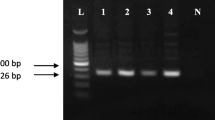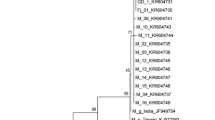Abstract
The peach root-knot nematode, Meloidogyne floridensis is an emerging pest of peach and other crops that is currently known to occur only in California, Florida, Georgia and South Carolina, USA. Morphological and morphometric differentiation of this species from other related species is difficult and requires taxonomic expertise. Molecular methods can provide rapid and reliable diagnostics of M. floridensis. Currently, molecular identification of M. floridensis is based on the analysis of the intergenic mitochondrial COII-16S region and the nad5 gene sequence polymorphism using PCR-RFLP and sequencing. However, these techniques are time-consuming and not appropriate for the analysis of large numbers of samples. In this study, RAPD and whole genome sequence datasets were used to reveal species-specific DNA fragments for M. floridensis to develop a new diagnostic method. A rapid method of M. floridensis detection using multiplex Real-time PCR with TaqMan probes of three different fluorescent reporter dyes was developed in this study. Multiplex Real-time PCR simultaneously observed amplifications of three fragments with the following primer/probe sets: set 1 – species-specific for M. floridensis/ M. hispanica; set 2- specific for the tropical group of the root-knot nematodes and set 3 - specific for the tropical group of the root-knot nematodes excluding M. floridensis. Positive signals from primer/probe sets 1 and 2 and a negative signal from primer/probe set 3 indicated the presence of M. floridensis in a sample. These results showed that Real-time PCR with specific primers and probes, was sensitive enough to detect the M. floridensis DNA extracted from a single second-stage juvenile specimen per a reaction tube alone or in mixture with other nematodes. Our results also showed that widely used diagnostics for the southern root-knot nematode, M. incognita based on PCR with species-specific primers can generate amplicons of similar lengths with M. floridensis samples and therefore, compromise these methods that were specifically developed for the detection of M. incognita. The Seville root-knot nematode, M. hispanica was also detected in Florida and Mexico for the first time as a results of our field sample testing.






Similar content being viewed by others
References
Álvarez-Ortega, S., Brito, J. A., & Subbotin, S. A. (2019). Multigene phylogeny of root-knot nematodes and molecular characterization of Meloidogyne nataliei Golden, Rose & Bird, 1981 (Nematoda: Tylenchida). Scientific Reports, 9, 11788.
Blok, V. C., & Powers, T. O. (2009). Biochemical and molecular identification. In R. Perry, M. Moens, & J. Starr (Eds.), Root-knot nematodes (pp. 98–118). CABI Publishing.
Blok, V. C., Phillips, M. S., & Fargette, M. (1997). Comparison of sequence differences in the intergenic region of the ribosomal cistron of Meloidogyne mayaguensis and the major tropical root-knot nematodes. Journal of Nematology, 29, 16–22.
Brito, J. A., Dickson, D. W., Kaur, R., Vau, S., & Stanley, J. D. (2015). The peach root-knot nematode: Meloidogyne floridensis, and its potential impact for the peach industry in Florida. Nematology Circular, Florida Department of Agriculture and Consumer Services, Division of Plant Industry, 224, 7.
Coolen, W. A. (1979). Methods for extraction of Meloidogyne spp. and other nematodes from roots and soil. In F. Lamberti & C. E. Taylor (Eds.), Root-knot nematodes (Meloidogyne species). Systematics, biology, and control (pp. 317–329). Academic Press.
Dong, K., Dean, R. A., Fortnum, B. A., & Lewis, S. A. (2001). Development of PCR primers to identify species of root-knot nematodes: Meloidogyne arenaria, M. hapla, M. incognita and M. javanica. Nematropica, 31, 271–280.
El-Ghore, A. A., Haroon, S., El Rheem, M. A., & Abdella, E. (2004). Development of specific SCAR-markers for Meloidogyne incognita and Meloidogyne javanica. Arab Journal of Biotechnology, 7, 37–44.
Handoo, Z. A., Nyczepir, A. P., Esmenjaud, D., van der Beek, J. G., Castagnone-Sereno, P., Carta, L. K., Skantar, A. M., & Higgins, J. A. (2004). Morphological, molecular, and differential-host characterization of Meloidogyne floridensis n. sp. (Nematoda: Meloidogynidae), a root-knot nematode parasitizing peach in Florida. Journal of Nematology, 36, 20–35.
Humphreys-Pereira, D. A., Flores-Chaves, L., Gómez, M., Salazar, L., Gómez-Alpizar, L., & Elling, A. A. (2014). Meloidogyne lopezi n. sp. (Nematoda: Meloidogynidae), a new root-knot nematode associated with coffee (Coffea arabica L.) in Costa Rica, its diagnosis and phylogenetic relationship with other coffee-parasitising Meloidogyne species. Nematology, 16, 643–661. https://doi.org/10.1163/15685411-00002794
Janssen, T., Karssen, G., Verhaeven, M., Coyne, D., & Bert, W. (2016). Mitochondrial coding genome analysis of tropical root-knot nematodes (Meloidogyne) supports haplotype based diagnostics and reveals evidence of recent reticulate evolution. Scientific Reports, 6, 22591. https://doi.org/10.1038/srep22591
Jeyaprakash, A., Tigano, M. S., Brito, J., Carneiro, R. M. D. G., & Dickson, D. W. (2006). Differentiation of Meloidogyne floridensis from M. arenaria using high-fidelity PCR amplified mitochondrial AT-rich sequences. Nematropica, 36, 1–12.
Katsuta, A., Toyota, K., Min, Y.Y., & Maung, T.T. (2016). Development of real-time PCR primers for the quantification of Meloidogyne graminicola, Hirschmanniella oryzae and Heterodera cajani, pests of the major crops in Myanmar. Nematology 18, 257–263. https://doi.org/10.1163/15685411-00002957.
Kiewnick, S., Wolf, S., Willareth, M., & Frey, J. E. (2013). Identification of the tropical root-knot nematode species Meloidogyne incognita, M. javanica and M. arenaria using a multiplex PCR assay. Nematology, 15, 891–894. https://doi.org/10.1163/15685411-00002751
Lunt, D. H., Kumar, S., Koutsovoulos, G., & Blaxter, M. L. (2014). The complex hybrid origins of the root knot nematodes revealed through comparative genomics. PeerJ, 2, e356. https://doi.org/10.7717/peerj.356
Maquilan, M .A. D., Sarkhosh, A., & Dickson, D. (2018). Peach root-knot nematode. The horticultural sciences department, UF/IFAS extension, HS1320, 5 pp. http://edis.ifas.ufl.edu/publication/HS1320. Accessed 11 Jul 2022
Marquez, J., Forghani, F., & Hajihassani, A. (2021). First report of the root-knot nematode, Meloidogyne floridensis, on tomato in Georgia, USA. Plant Disease, 105, 1228. https://doi.org/10.1094/PDIS-10-20-2286-PDN
Meng, Q. P., Long, H., & Xu, J. H. (2004). PCR assays for rapid and sensitive identification of three major root-knot nematodes, Meloidogyne incognita, M. javanica and M. arenaria. Acta Phytopathologica Sinica, 34, 204–210.
Powers, T. O., & Harris, T. S. (1993). A polymerase chain reaction for the identification of five major Meloidogyne species. Journal of Nematology, 25, 1–6.
Randig, O., Bongiovanni, M., Carneiro, R. M. D. G., & Castagnone-Sereno, P. (2002). Genetic diversity of root-knot nematodes from Brazil and development of SCAR markers specific for the coffee-damaging species. Genome, 45, 862–870. https://doi.org/10.1139/g02-054
Reighard, G. L., Henderson, W. G., Scott, S. O., & Subbotin, S. A. (2019). First report of the root-knot nematode, Meloidogyne floridensis infecting Guardian peach rootstock in South Carolina, USA. Journal of Nematology, 51, e2019–e2061. https://doi.org/10.21307/jofnem-2019-061
Skantar, A. M., Handoo, Z. A., Subbotin, S. A., Kantor, M. R., Vieira, P., Agudelo, P., Hult, M. N., & Rogers, S. (2021). First report of Seville root-knot nematode, Meloidogyne hispanica (Nematoda: Meloidogynidae) in the USA and North America. Journal of Nematology, 53, e2021–e2098. https://doi.org/10.21307/jofnem-2021-098
Smith, T., Brito, J. A., Han, H., Kaur, R., Cetintas, R., & Dickson, D. W. (2015). Identification of the peach root-knot nematode, Meloidogyne floridensis, using mtDNA PCR-RFLP. Nematropica, 45, 138–143.
Subbotin, S. A. (2021). Molecular identification of nematodes using polymerase chain reaction (PCR). In R. N. Perry, D. Hunt, & S. A. Subbotin (Eds.), Techniques for work with plant and soil nematodes (pp. 218–239). CABI.
Subbotin, S. A., Palomares-Rius, J. E., & Castillo, P. (2021). Systematics of root-knot nematodes (Nematoda: Meloidogynidae). In D. J. Hunt & R. N. Perry (Eds.), Nematology monographs and perspectives (Vol. 14, p. 847). Brill.
Szitenberg, A., Salazar-Jaramillo, L., Blok, V. C., Laetsch, D. R., Joseph, S., Williamson, V. M., Blaxter, M. L., & Lunt, D. H. (2017). Comparative genomics of apomictic root-knot nematodes: Hybridization, ploidy, and dynamic genome change. Genome Biology and Evolution, 9, 2844–2861. https://doi.org/10.1093/gbe/evx201
Thompson, J. D., Gibson, T. J., Plewniak, F., Jeanmougin, F., & Higgins, D. G. (1997). The CLUSTAL X windows interface: Flexible strategies for multiple sequence alignment aided by quality analysis tools. Nucleic Acids Research, 25, 4876–4882. https://doi.org/10.1093/nar/25.24.4876
Tigano, M. S., Carneiro, R. M. D. G., Jeyaprakash, A., Dickson, D. W., & Adams, B. J. (2005). Phylogeny of Meloidogyne spp. based on 18S rDNA and the intergenic region of mitochondrial DNA sequences. Nematology, 7, 851–862. https://doi.org/10.1163/156854105776186325
Westphal, A., Maung, Z. T. Z., Doll, D. A., Yaghmour, M. A., Chitambar, J. J., & Subbotin, S. A. (2019). First report of the peach root-knot nematode, Meloidogyne floridensis infecting almond on root-knot nematode resistant 'Hansen 536′ and 'Bright's hybrid 5′ rootstocks in California, USA. Journal of Nematology, 51, e2019–e2012. https://doi.org/10.21307/jofnem-2019-002
Zijlstra, C., & van Hoof, R. A. (2006). A multiplex real-time polymerase chain reaction (TaqMan) assay for the simultaneous detection of Meloidogyne chitwoodi and M. fallax. Phytopathology, 96, 1255–1262. https://doi.org/10.1094/PHYTO-96-1255
Acknowledgements
The authors thank Drs. P. Castillo, I.M. Escobar-Avila, A. Ploeg, P. Roberts, A. Westphal, and V. Williamson for providing the root-knot nematode samples. This work was sponsored by the California Department of Food and Agriculture Emergency Fund.
Author information
Authors and Affiliations
Corresponding author
Ethics declarations
The research did not involve any studies with human participants or animals performed by any of the authors, and all authors informed consent.
Conflict of interest
All authors herewith declare that there is no conflict of interests. All authors are informed and agree on the publication of the manuscript.
Rights and permissions
About this article
Cite this article
Yimer, H., Burbridge, J., Brito, J.A. et al. Diagnostics of the peach root-knot nematode, Meloidogyne floridensis using multiplex real-time PCR. Eur J Plant Pathol 164, 109–123 (2022). https://doi.org/10.1007/s10658-022-02542-6
Accepted:
Published:
Issue Date:
DOI: https://doi.org/10.1007/s10658-022-02542-6




